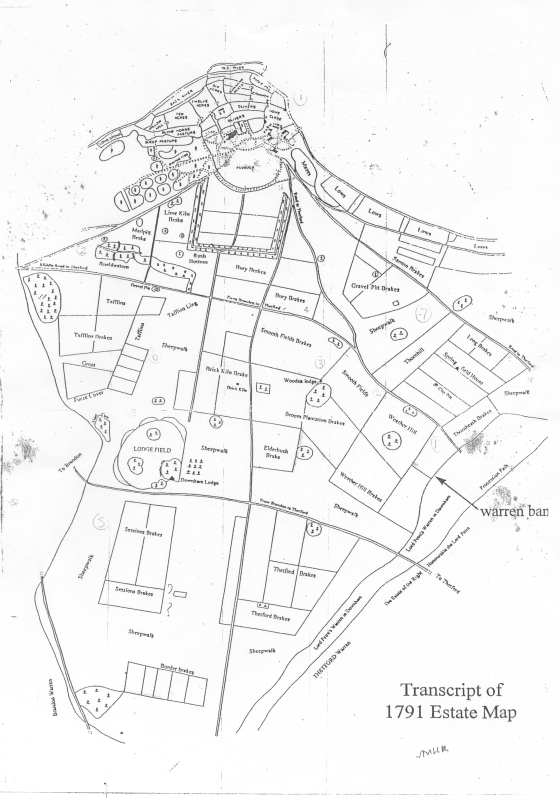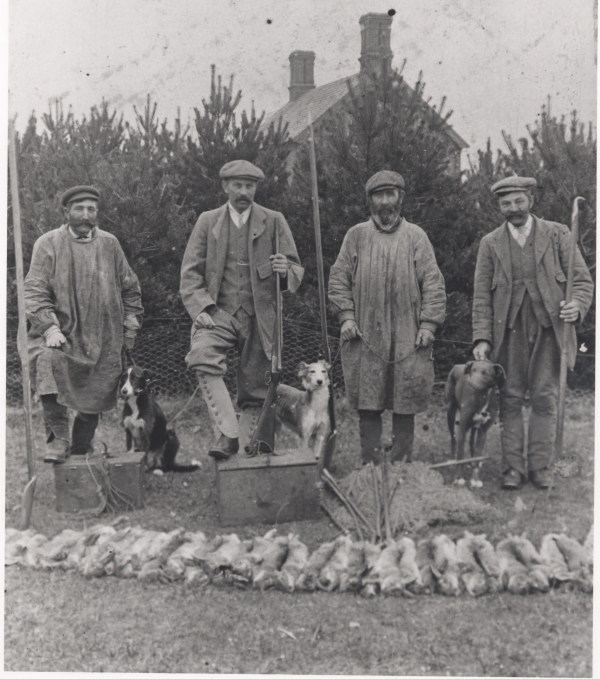



To most of us, rabbits are either cuddly household pets or a pest in our gardens, on our farms and in our forests.
If you lived in the medieval period and were a peasant, you were not allowed to eat rabbit meat nor wear rabbit fur. In fact, only those who were lords of the manor could do so - and there was a strict hierarchy as to what colour fur you could wear, according to your rank.
The right of owning a warren was a manorial one, bought from the Crown, a warren being defined as an area designated for the farming of rabbits for their meat and their fur, in which they were nurtured, protected and trapped by a warrener as highly-prized, high status luxury items, just as designer brands are today.
Each of the nineteen medieval rabbit warrens of Breckland had a warren lodge, usually on the highest point of the warren, hence the name 'High Lodge'.
The lodge in which the warrener lived had to serve a threefold purpose: accommodation for the warrener and family; storage for the trapping equipment and carcasses; and a look-out and defence against poachers
The foundations of Downham Lodge have not yet been found but old maps give some idea of its general location.

Archival records, drawings and the standing buildings of Mildenhall and Thetford Warren Lodges give clues as to what Downham Warren Lodge probably looked like.
There is a detailed account of the construction of Brandon Warren Lodge in 1382 in the Brandon Manor Account Records.
'14 foot long and 12 foot wide to start from a firm foundation … the walls shall be 20 foot hight … the first chamber shall be 12 feet hight from ground level, the second chamber 8 feet hight'. Free-stone as necessary;); 160 cartloads of stone and 1 scraper for collecting the stones; dug chalk; dug clunch for walling, dug sand; 5 poplar boards; 100 nails; 1 Estonian board for making a bar to close the door; whitewash and 24 hurdles for making a fence.
Last of all in the Account is 'present given to the masons, by command of the chief steward, 4d'.
| Material | Use |
|---|---|
| Free-stone | For the corner stones of the building and for door and window surrounds - probably limestone from the medieval quarry at Barnack, Northamptonshire |
| Quicklime | For whitewashing the interior walls as it had disinfectant qualities – but it was extremely caustic, being created by heating chalk or lime andit had to be slaked (wetted) before use and slaking was dangerous as much heat and spitting occurs. |
| Cartloads of stone | Probably flint nodules for the walls; to be shaped and laid in courses. |
| Dug chalk | For ramming and possibly for the floor to be rammed down when moist and then allowed to dry out. |
| Dug clunch | Used along with the flint for the walls. |
| Dug Sand | Mixed with the chalk and water to make the lime mortar to fill in the gaps between the flints and embed them to make the walls. |
| Nails | For any of the timber structures such as the stairs and the door. Timber pegs were used as well. |
| Poplar boards | for making the ‘sinktre’ (an arch or vault support) |
| Estonian board | From the Baltic, for making a bar to close the door. |
The ground floor was used to store the rabbit carcasses, the nets, traps and lanterns with slit openings in the walls, possibly for ventilation and light. The living accommodation was on the first floor and both lodges have fireplaces.
Because of the threat from poachers, the lodges were defensive, with a window in each of the four walls on the upper floor, to allow the warrener to look out over the warren and only a single doorway.
The quality of the masonry suggests that these were high status buildings, reflecting the importance of rabbits in the medieval economy.
An inventory of 1662 for 'the late George Childerstons of Mildenhall … warrener' includes 'at the warren lodge one bed with a flockbed 3 ould hayes or stetts and other implements belonging to the warrener.' (WSROB 633/1-2).
A brown ink drawing of the Warren Lodge, Thetford, by Thomas Martin in 1740 has the following note beside it: This sketch was taken 17 Decr 1740 a very cold frost and Snowy day tis drawn too wide and should be higher particularly the watch tower narrower. The Revd. Mr John Wright Rector of Euston and Mr Alexander Falconer with my self din'd here this day on three excellent fat Conies Roasted
(Ancient House Museum, Thetford T.976.431).
Frank Norgate's Diary in the Norfolk Record Office gives more information. On 19th December 1885 Norgate described a walk to Thetford Warren Lodge (or Fort) which we looked over. It seems to have formerly been a strong place as if for defence, the windows are narrow slits in very thick walls.
In the margin of his diary, he notes Winding stone staircase very large rooms and 4 to 5 large bedsteads in one room. Warreners congregate here for preparing big bags of rabbits for market or other purposes.
(Norfolk Record Office MC 175/12, 13, 638 x 2).
The Warren Lodge was the workplace and the dwelling place of the warrener. Built on the highest point of the warren to give him the best view across it, it also gave him protection against poachers. This is where the name "High Lodge" comes from. The ground floor was used to store the rabbit carcasses, the nets, traps and lanterns, while the living accommodation was on the first floor.
Downham Lodge is shown on a series of maps: 1736; 1783; 1791 and 1794.
The Lodge is marked on the Cadogan Estate Map of 1791 with "Lodge Field", enclosed by internal banks. The lodge was close to where Oak Lodge Community Building now stands. High Lodge Forest Centre is within the "Lodge Field".
The first warrener whose name is recorded is Ealfrido (Geoffrey) 'le warrener' of Freckenham in 1295.
The warrener had to judge the condition of his stock, regulate the number of bucks to does, organise extra labour for the autumn and winter culls, protect the coneys from extremes of weather and consider the economics of the market for his produce, once the needs of his manorial master's household had been met.
A crucial part of the warrener's work was to protect the coneys from predators - natural ones such as weasels, stoats, foxes and polecats - but also from human ones! Poaching was big business throughout the existence of the warrens.

Tom Turner, warrener and game-keeper on the estate recalls The real old rabbit catchers all had what we called smocks … made of stout stuff and looped around the neck and brought down just below the knee. You could be out practically all day in rain or snow and you wouldn't get wet.
It has also been said that they were roomy enough for rabbits to be hung around the belt worn underneath!